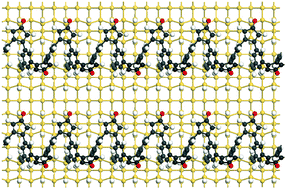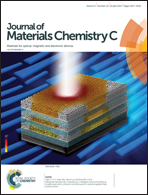Theoretical study on the self-assembly of 1,3,5-triethynylbenzene on Si(100)2 × 1 and in situ polymerization via reaction with CO to fabricate a single surface-grafted polymer†
Abstract
Based on density functional theory (DFT) calculations, we studied a two-step surface reaction for fabricating conductive molecular wires on hydrogen-terminated Si(100)2 × 1 surfaces. The first step is the self-assembled growth of 1,3,5-triethynylbenzene (TEB) molecules and formation of aligned molecular arrays on a H–Si(100)2 × 1 surface, and the second step is the in situ polymerization of the adsorbed molecules with CO via formal [2 + 2 + 1] cycloaddition reactions to produce a surface-grafted molecular wire, which is chemically bonded to the Si surface and electronically interlinked. The newly formed polymer/Si(100)2 × 1 structure is semiconducting and can be tuned to be conductive by electron doping; in this structure the molecular wires are the sole conducting channels and the Si substrate retains its semiconducting characteristics. Such unique properties make these surface-grafted molecular wires or polymers potential candidates in molecular electronics.



 Please wait while we load your content...
Please wait while we load your content...